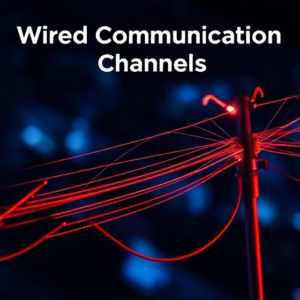A communication channel is a pathway or medium through which information (like voice, data, or video) is transmitted from one place to another. Think of it as a “road” that carries the data from the sender to the receiver.
Types of Communication Channels
There are different types of communication channels, depending on the medium used to transmit the information:

1. Wired Communication Channels
These channels use physical cables or wires to transmit information.
- Examples:
- Telephone lines: Traditional landline phones use copper wires to transmit sound (voice).
- Fiber-optic cables: These use light signals to transmit data, often used for high-speed internet.
- Coaxial cables: Used for cable TV and internet connections.
- Why it’s important: Wired channels are reliable and can provide high-quality transmission, but they are limited by the need for physical infrastructure (wires and cables). They can also be expensive to install over long distances.
2. Wireless Communication Channels
These channels transmit information through the air, without the need for physical cables. They use radio waves, microwaves, and other electromagnetic signals.
- Examples:
- Radio waves: Used in radio broadcasting and television signals.
- Microwaves: Used in satellite communication, mobile phones, and Wi-Fi.
- Infrared: Used for short-range communication, like remote controls.
- Bluetooth: Used for wireless communication between devices like phones, headphones, and speakers.
- Wi-Fi: Used to connect devices like smartphones, laptops, and tablets to the internet wirelessly.
- Why it’s important: Wireless channels are convenient because they allow communication without the need for physical wires. However, they can be more prone to interference, noise, and security concerns.
3. Optical Communication Channels
These use light to transmit information, often over fiber-optic cables or through the air using lasers.
- Examples:
- Fiber-optic cables: Transmit data as light signals. They are used for high-speed internet, phone systems, and TV.
- Free-space optical communication: Uses lasers to send information through the air, typically for satellite communication or short-range wireless links.
- Why it’s important: Optical channels can carry huge amounts of data at very high speeds, and they are not affected by electromagnetic interference. They are ideal for long-distance communication but require expensive infrastructure.
4. Broadcast Communication Channels
These are channels used to send the same signal to multiple receivers at once. In other words, information is broadcasted to many people or devices at the same time.
- Examples:
- Radio and TV: Broadcast signals are sent out to anyone within range who has the right receiver.
- Satellite TV: Satellite signals are broadcast from a satellite to the Earth, where they are received by many people at once.
- Why it’s important: Broadcast channels are efficient for reaching large audiences, especially in real-time communication (like news or live sports).
5. Point-to-Point Communication Channels
These are channels that transmit information from one specific point (sender) to another specific point (receiver).
- Examples:
- Telephone calls: The call is between two phones, and the information is transmitted directly between them.
- Wi-Fi networks: A laptop connecting to a router is an example of point-to-point communication over a wireless channel.
- Why it’s important: Point-to-point channels provide a direct, private communication between two devices or people, making them suitable for personal conversations, secure data transmission, and other focused exchanges.
6. Simplex, Half-Duplex, and Full-Duplex Channels
These describe how data flows through the communication channel:
- Simplex: Data flows in only one direction (e.g., a radio station broadcasting to listeners).
- Example: TV broadcasting.
- Half-Duplex: Data flows in both directions, but not at the same time. You can send or receive, but not both simultaneously.
- Example: Walkie-talkies (one person talks, the other listens, then they switch roles).
- Full-Duplex: Data flows in both directions at the same time. Both people can talk and listen at the same time.
- Example: Telephone calls (both people talk and listen simultaneously).
7. Communication Channel Properties
There are certain qualities that determine how good a channel is for communication:
- Bandwidth: The capacity of the channel, or how much data can be transmitted at once. A higher bandwidth means more data can be sent.
- Noise: Unwanted interference that can distort the signal. Channels with low noise provide clearer communication.
- Latency: The delay in sending and receiving data. Low latency means quicker communication.
- Error Rate: The number of errors that occur in the transmission. A low error rate means the information is more accurate.
Why Are Communication Channels Important?
Communication channels are the backbone of all communication systems—from talking on the phone, to using the internet, to watching TV. They define how efficiently, quickly, and clearly we can exchange information. Different channels have their own strengths and weaknesses, so it’s important to choose the right one for the specific task or need.
In Summary:
- Communication channels are pathways that carry information from one place to another.
- They can be wired (e.g., fiber-optic cables), wireless (e.g., radio waves, Wi-Fi), or even optical (e.g., fiber-optic cables).
- Broadcast channels send the same signal to many receivers, while point-to-point channels connect two specific points.
- Channels can be simplex (one-way), half-duplex (two-way, but not at the same time), or full-duplex (two-way, simultaneously).
Tags: Bandwidth, Bluetooth, broadcast channels, cable TV, coaxial cables, communication channel, Communication channels, communication efficiency., communication mediums, Communication Protocols, communication reliability, Communication Systems, data flow, data pathways, Data transmission, direct communication, electromagnetic signals, error rate, fiber optic cables, free-space optical communication, full-duplex communication, half-duplex communication, high-speed internet, infrared communication, latency, microwaves, multi-receiver broadcast, network infrastructure, noise, Optical communication, point-to-point channels, Radio Waves, real-time communication, Satellite communication, Secure communication, signal clarity, Signal interference, signal transmission, simplex communication, telephone lines, transmission delay, Wi-Fi, wired communication, wireless communication, wireless networks


